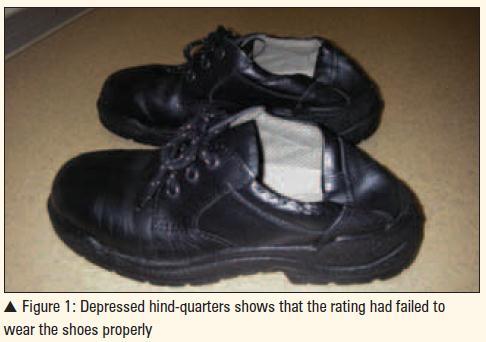200960 A fall down stairs
 A newly-joined catering rating suffered chest and elbow injuries due to a fall down a stairway. The vessel was at anchor at the time of the accident, with wind conditions up to force 7 Beaufort scale with a 4-metre swell.
A newly-joined catering rating suffered chest and elbow injuries due to a fall down a stairway. The vessel was at anchor at the time of the accident, with wind conditions up to force 7 Beaufort scale with a 4-metre swell.
The chief cook had instructed the rating to bring some empty cartons from the provision store located a deck below. Soon after the rating left the galley, the cook heard the sound of a fall coming from the stairwell. He found the rating at the bottom of the stairs, rising to his feet with some difficulty. After recovering his composure, the rating claimed that while descending the stairs, empty-handed and holding the rail, his footing slipped and he lost his balance. He fell forward, hitting his chest against the railing and his elbow on the ladder steps while trying to protect his head from impact.
First aid was administered to the injured rating immediately. About two days later, he was examined by a shore physician, declared unfit for duty and had to be repatriated home.
A thorough root cause investigation was carried out after the accident, with the following conclusions:
- There was evidence that the rating was not wearing his safety shoes properly and this was a contributory factor in the accident. The depressed hind-quarters of the rating's shoes indicated that he had only slipped his feet in without putting them on properly.
- The rating had joined the ship one day prior to the accident after a long flight. It is possible that he might not have been very vigilant as a result of jet lag.
- Effects of seasickness could also have been a contributing factor.
Lessons learned
- It must be emphasised that any personal protective-equipment (PPE), including safety shoes, should be worn in the correct manner and any modification or misuse of PPE is against good seamanship and safety procedures.
- In the case of safety shoes, these need to be:
- the correct size - oversized shoes can come off easily;
- worn properly with the laces secured tight.
- Crew members should be especially careful when a new tour of duty begins; it requires some time to get familiar with new work environment, equipment or people.
- Senior crew members should guide those with less experience in operational safety.
